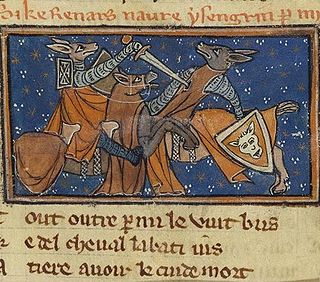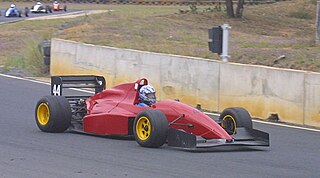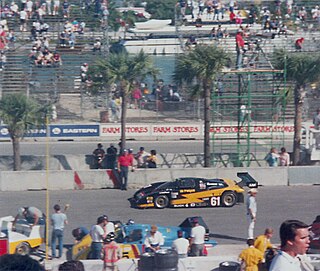Related Research Articles

Reynard the Fox is a literary cycle of medieval allegorical Dutch, English, French and German fables. The first extant versions of the cycle date from the second half of the 12th century. The genre was popular throughout the Late Middle Ages, as well as in chapbook form throughout the Early Modern period.
Pacific Racing was a motor racing team from the United Kingdom. Following success in lower formulae, the team took part in two full seasons of Formula One, in 1994 and 1995, entering 33 Grands Prix without any success.
Arthur Edward Abrahams is a semi-retired Australian race car driver. He won the 1987, 1991 and 1993 Australian Formula 2 Championships driving a Cheetah Mk8, Ransburg Cheetah and Reynard 913 respectively. he also won the Australian group C touring car endurance championship (1600cc) in 1984. He competed in International Sportscars in Europe and in American open wheel racing cars. He also competed in Formula Brabham/Holden for three years, debuting in 1994 and leaving the category in 1996. He was owner of the NRC International team in Formula Holden before running Dale Brede amongst others in V8 Supercar's Development Series. In 2001 Abrahams stepped away from the sport to focus on his and family business interests.
Adrian John Reynard is a businessman and commercial astronaut. He is the founder of Reynard Motorsport, which was a successful racing car manufacturer before it went bankrupt in 2002.

Formula Holden was an Australian open wheel racing category introduced in 1989.
The Barber Dodge Pro Series was a professional open-wheel auto racing series from 1986 to 2003. It was one of the first professional spec series for open-wheel racecars in North America. The races were primarily on road and street courses in North America, although the schedule did sometimes include a few ovals.

Argo Racing Cars Ltd. is a British racing constructor founded by Swiss designer Jo Marquart and British mechanic Nick Jordan as part of their Anglia Cars racing team in the 1980s. The company initially constructed a variety of open-wheel cars for national and international Formula Three, as well as the Formula Atlantic and Formula Super Vee series. The company later built sports prototypes for the World Sportscar Championship's C2 class and the North American IMSA GT Championship's IMSA Lights category, winning several championships.

Reynard Motorsport was the world's largest racing car manufacturer in the 1980s. Initially based at Bicester and latterly at Reynard Park, Brackley, England the company built successful cars in Formula Ford 1600, Formula Ford 2000, Formula Vauxhall Lotus, Formula Three, Formula 3000 and CART.

The March 74S is a Group 5 prototype race car, designed, developed and built by British manufacturer March Engineering, for sports car racing, in 1974.

The Reynard 923 is an open-wheel Formula 3 race car, developed and built by Reynard in 1992.
The March 733 was a Formula 3 car built by March Engineering in 1973. Tony Brise won the 1973 Championship driving this car. It is powered by the 1.6 L (98 cu in) Ford Twin Cam straight-four engine.

The March 712 was an open-wheel Formula 2 race car, designed, developed and built by British manufacturer March, in 1971. It was very successful, with Swede Ronnie Peterson winning the 1972 European F2 Championship season in a Cosworth-powered 712. Peterson won 5 races that season, and took 6 podium finishes, as well as taking 7 pole positions, and 5 fastest laps. Peterson finished the championship in first place, with 54 points. Austrian Dieter Quester, also driving a March 712, finished the championship in third place, with 31 points, driving a BMW-powered 712. The 712 was powered by either a Ford-Cosworth FVA, or a BMW M12/7; which were both naturally-aspirated 1.6 L (98 cu in) four-cylinder engines. A sister variant of the car, called the March 71B, was the Formula B (Atlantic) version of the car.
The March 76S is a Group 6 prototype race car, designed, developed and built by British manufacturer March Engineering, for sports car racing, in 1976.
The Reynard F3000 cars are open-wheeled Formula 3000 cars, designed and developed by Malcolm Oastler, and constructed and built by British manufacturer Reynard Motorsport.

The Reynard 893 is an open-wheel Formula 3 race car, developed and built by Reynard in 1989.

The Reynard 903 is an open-wheel Formula 3 race car, developed and built by Reynard in 1990.
The Reynard 883 is an open-wheel Formula 3 race car, developed and built by Reynard in 1988.
The Reynard 863 is an open-wheel Formula 3 race car, designed, developed and built by Reynard in 1986.
The Dallara F3 cars are open-wheel formula racing car, designed, developed and built by Italian manufacturer Dallara, for Formula Three categories.

The March 742 is an open-wheel race car, designed, developed and built by British manufacturer March Engineering, and constructed to Formula Two regulations, and introduced for the 1974 championship. It's Formula Atlantic equivalent, used in the Atlantic Championship, known as the March 74B, was based on the 742.
References
- ↑ "Reynard 913 in monoposto spec". racecarsdirect.com. 3 October 2022.
- ↑ "REYNARD 913". racecarsdirect.com.